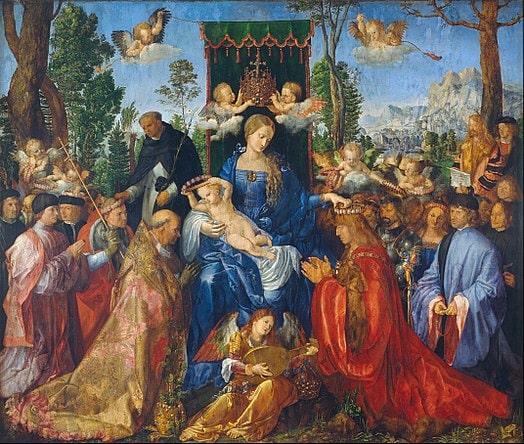Albrecht Dürer’s paintings hold immense importance as iconic representations of Northern Renaissance art.
His technical mastery, intricate details, and innovative printmaking influenced generations. Works like “Melencolia I” showcase intellectual depth, while portraits like “Self-Portrait at Twenty-Eight” reflect his individuality.
Dürer’s religious and mythological subjects, seen in “Knight, Death, and the Devil,” capture profound symbolism. His artistic legacy, marked by innovation and skill, remains a cornerstone in the evolution of European art.
Self-Portrait at Twenty-Eight
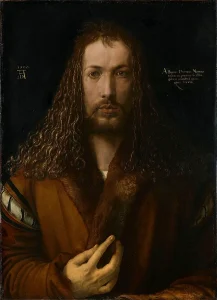
Self-Portrait at Twenty-Eight (1500) by Albrecht Dürer is a seminal work capturing the artist’s youthful vigor and self-assuredness. Dürer skillfully renders details, from the meticulous curls of his hair to the intensity of his gaze. This iconic self-portrait reflects the artist’s technical mastery and introspective depth, establishing a timeless connection with viewers.
Adam and Eve
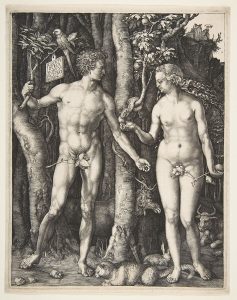
Adam and Eve (1504) by Albrecht Dürer depicts the biblical couple in an intimate garden setting. Dürer’s meticulous details showcase his technical prowess, from the texture of foliage to the expressions on Adam and Eve’s faces. This engraving explores the nuanced emotions of temptation and consequences, embodying the Renaissance spirit.
Praying Hands
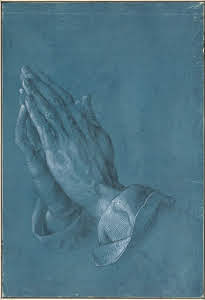
Praying Hands (c. 1508) by Albrecht Dürer is an iconic study of devotion. This drawing captures the humility and sincerity of hands engaged in prayer. Dürer’s meticulous shading and anatomical precision elevate a simple gesture to a profound symbol of faith, resonating with viewers across centuries.
Knight, Death, and the Devil
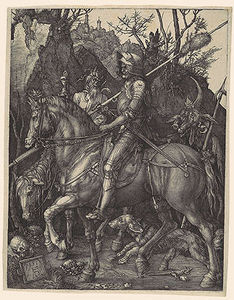
Knight, Death, and the Devil (1513) by Albrecht Dürer is a masterful copper engraving. It depicts a knight, stoically facing adversity, accompanied by death and the devil. Symbolic and detailed, the work explores moral fortitude and the human condition, showcasing Dürer’s technical brilliance and profound philosophical depth.
Melencolia I
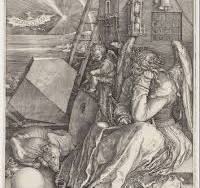
Melencolia I (1514) by Albrecht Dürer is a mysterious and intricate engraving. In this depiction of melancholy, a winged genius sits surrounded by tools and symbols, suggesting the tension between artistic inspiration and the burdens of knowledge. Dürer’s meticulous details and symbolism make it a captivating and enigmatic masterpiece.
The Rhinoceros
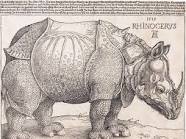
The Rhinoceros (1515) by Albrecht Dürer is a woodcut depicting a rhinoceros, based on a description rather than direct observation. Despite inaccuracies, Dürer’s detailed rendering ignited European fascination with exotic creatures. This work reflects Renaissance curiosity and the intersection of art, exploration, and the unknown in the 16th century.
Portrait of a Young Venetian Woman
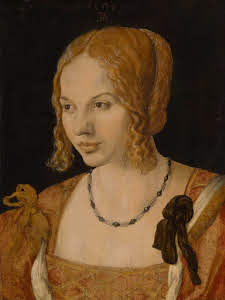
Portrait of a Young Venetian Woman by Albrecht Dürer (c. 1505) exemplifies his finesse in capturing nuanced expressions. The subject’s gaze exudes grace and intelligence, and Dürer’s meticulous detailing extends to her attire. This portrait stands as a testament to Dürer’s ability to convey both external beauty and inner depth.
The Large Turf
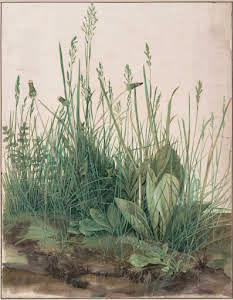
The Large Turf (1503) by Albrecht Dürer is a watercolor masterpiece showcasing his meticulous botanical precision. Dürer elevates a simple subject—an assortment of wild plants—to a celebration of nature’s intricacies. The vibrancy and detail in this work reflect Dürer’s keen observation and pioneering contributions to naturalistic art.
The Adoration of the Magi
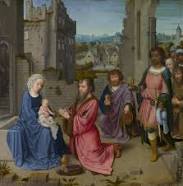
The Adoration of the Magi by Albrecht Dürer (1504) is a captivating woodcut capturing the biblical scene. Dürer’s meticulous lines and intricate detailing bring the narrative to life. The composition, rich in symbolism, reflects Dürer’s skill in harmonizing religious themes with artistic innovation during the Northern Renaissance.
Portrait of Hieronymus Holzschuher
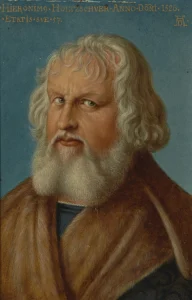
Portrait of Hieronymus Holzschuher (1526) by Albrecht Dürer showcases the artist’s mastery in portraiture. Dürer meticulously details Holzschuher’s features, attire, and the intricate patterns of the fur. The portrait exudes a dignified and timeless quality, testament to Dürer’s ability to capture both the physical likeness and the inner essence of his subjects.
The Four Horsemen of the Apocalypse
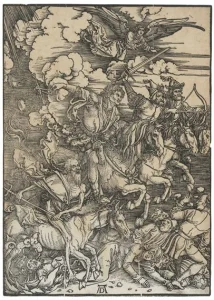
The Four Horsemen of the Apocalypse (c. 1497–1498) by Albrecht Dürer is a woodcut illustrating the biblical imagery of conquest, war, famine, and death. Dürer’s expressive lines and dynamic composition vividly convey the apocalyptic themes. This work exemplifies his prowess in translating complex narratives into powerful visual representations.
St. Jerome in His Study
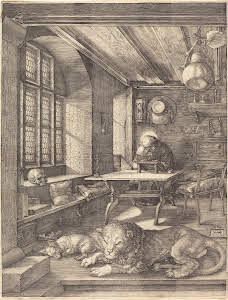
St. Jerome in His Study (1514) by Albrecht Dürer is a profound depiction of the scholar-saint immersed in contemplation. Dürer’s meticulous detailing extends to the scholarly tools and symbolic elements, capturing the intensity of Jerome’s intellectual pursuits. This engraving reflects the Renaissance fascination with introspection and intellectual endeavor.
The Small Horse
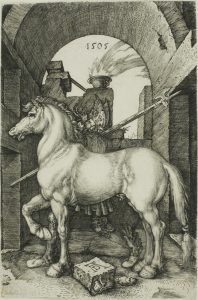
The Small Horse (1505) by Albrecht Dürer is a captivating watercolor portraying a diminutive, finely detailed horse. This work showcases Dürer’s fascination with animals and his ability to imbue them with lifelike qualities. The small yet intricate painting reflects Dürer’s pioneering contributions to naturalistic art during the Renaissance.
The Last Supper
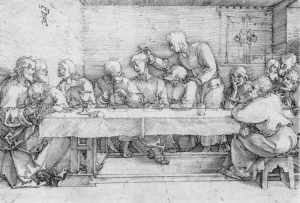
The Last Supper (c. 1523) by Albrecht Dürer is a woodcut illustrating the poignant biblical scene. Dürer’s expressive lines and thoughtful composition imbue the moment with emotional depth. This work reflects his ability to convey the humanity and spiritual significance of iconic narratives through his distinctive artistic style during the Northern Renaissance.
Portrait of Jakob Muffel
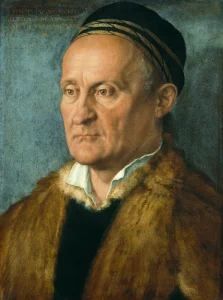
Portrait of Jakob Muffel (1526) by Albrecht Dürer is a masterful depiction of the Nuremberg patrician. Dürer’s meticulous detailing extends to Muffel’s intricate attire and the imposing presence of his figure. The portrait emanates dignity and richness, exemplifying Dürer’s ability to capture both the physical and psychological nuances of his subjects.
The Little Owl

The Little Owl (1506) by Albrecht Dürer is a striking watercolor study of a perched owl. Dürer’s meticulous attention to detail captures the bird’s features and textures with remarkable precision. This small yet powerful work reflects Dürer’s fascination with nature and his pioneering contributions to the art of animal representation during the Renaissance.
The Annunciation

The Annunciation (c. 1511) by Albrecht Dürer is a woodcut masterpiece portraying the biblical scene of the angel Gabriel announcing the Virgin Mary’s impending motherhood. Dürer’s meticulous lines and emotional depth convey the sacred moment with grace, exemplifying his ability to infuse spiritual narratives with artistic brilliance during the Renaissance.
The Madonna of the Pear
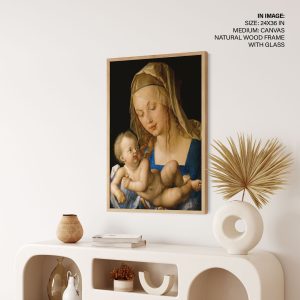
The Madonna of the Pear (1512) by Albrecht Dürer is a tender depiction of the Virgin Mary and infant Jesus. Dürer’s meticulous details extend to the symbolic pear, representing divine wisdom. The composition, rich in emotional depth and symbolism, exemplifies Dürer’s ability to infuse sacred narratives with profound artistic expression during the Renaissance.
Portrait of a Young Man

Portrait of a Young Man (1507) by Albrecht Dürer is a captivating study of youthful elegance. Dürer’s meticulous detailing, from the subject’s attire to the delicate rendering of facial features, captures the vibrancy of youth. This portrait reflects Dürer’s ability to convey both external beauty and inner depth with finesse.
Portrait of Michael Wolgemut

Portrait of Michael Wolgemut (1516) by Albrecht Dürer is a striking depiction of his mentor and fellow artist. Dürer’s meticulous detailing, from Wolgemut’s expressive features to his distinctive attire, pays homage to the esteemed master. This portrait exemplifies Dürer’s ability to capture the essence of his subjects with skill and reverence.
The Holy Family with the Dragonfly
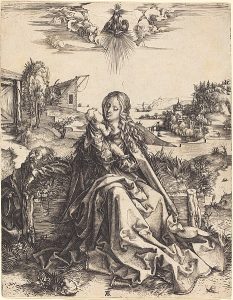
The Holy Family with the Dragonfly (1495) by Albrecht Dürer is a poignant portrayal of the Holy Family. Dürer’s meticulous details, including the dragonfly symbolizing transformation, contribute to the rich symbolism. This early work demonstrates Dürer’s exploration of religious themes and his ability to infuse them with profound meaning during the Northern Renaissance.
The Sea Monster
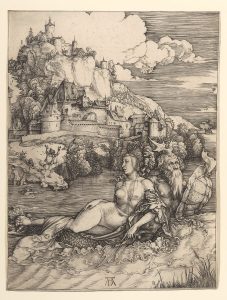
The Sea Monster (1498) by Albrecht Dürer is a captivating woodcut portraying a fantastical marine creature. Dürer’s meticulous lines and intricate detailing contribute to the mysterious allure of this imaginative work. This print showcases Dürer’s fascination with both the natural and mythical realms during the Renaissance.
Portrait of Frederick III of Saxony

Portrait of Frederick III of Saxony (1496) by Albrecht Dürer is a regal portrayal of the Elector of Saxony. Dürer’s meticulous detailing, from Frederick’s attire to his dignified expression, captures the subject’s authority. The portrait exemplifies Dürer’s ability to convey both the external grandeur and inner character of his subjects.
Madonna and Child with a Pear
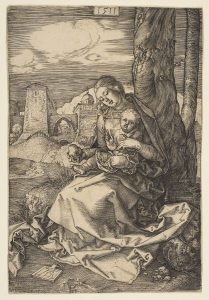
Madonna and Child with a Pear (c. 1512) by Albrecht Dürer is a tender portrayal of the Virgin Mary and infant Jesus. Dürer’s meticulous detailing extends to the symbolic pear, representing divine wisdom. This composition radiates with emotional depth and spiritual significance, showcasing Dürer’s mastery in conveying sacred narratives.
The Four Apostles

The Four Apostles (1526) by Albrecht Dürer is a profound depiction of apostles Peter, Paul, John, and Mark. Dürer’s meticulous detailing, from their expressions to the symbolic elements, captures their individual characteristics. This masterful painting reflects Dürer’s ability to infuse religious subjects with deep emotional and spiritual resonance during the Northern Renaissance.


